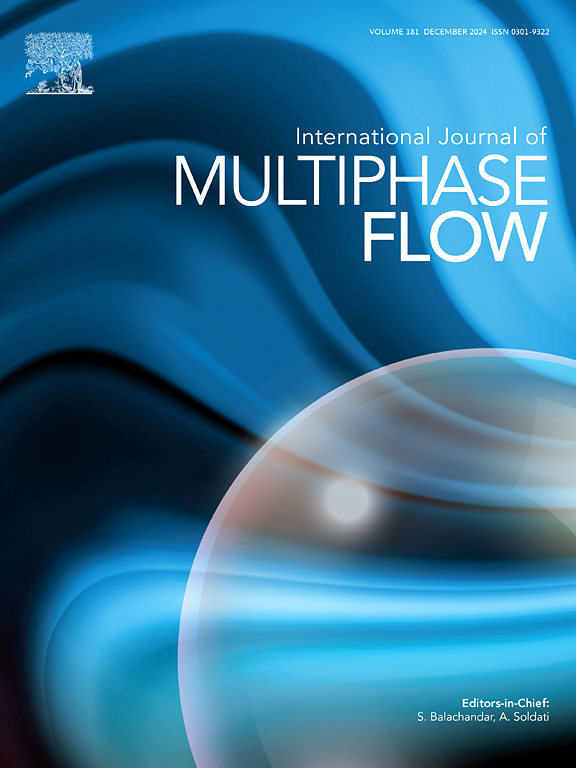Investigation of single saltwater droplet impact solidification and prediction method for macroscopic ice accretion on a flat surface
IF 3.6
2区 工程技术
Q1 MECHANICS
International Journal of Multiphase Flow
Pub Date : 2025-01-09
DOI:10.1016/j.ijmultiphaseflow.2025.105128
引用次数: 0
Abstract
Seawater droplet freezing threatens offshore structures, vessels and marine engine air intake systems. Yet, single droplet freezing and its link to macroscopic ice accretion are poorly understood. The paper investigates the impact of single supercooled saltwater droplets on a flat surface as its starting point. It employs the Coupled Level-Set and Volume-of-Fluid (CLSVOF) and Enthalpy-Porosity (EP) method to establish a numerical model for droplet impact freezing. The study analyzes various factors affecting single droplet spreading flow characteristics, transient heat transfer properties, and impact freezing dynamics. A mechanism equating the dimensionless impact time of a single droplet to the dimensionless impact time interval between multiple droplets is established. Moreover, a mathematical model predicting ice thickness on flat surfaces is proposed based on the freezing fraction corresponding to the Liquid Water Content (LWC) of single droplet. Finally, experimental results of ice accretion thickness on flat panel (ice blade) were obtained under different parametric conditions in an ice tunnel. Through comparative analysis, the validity of the proposed method for predicting ice accretion thickness on flat surfaces was confirmed. This predictive method effectively considers various factors such as salinity, velocity, temperature, and diameter, providing valuable insights for studying ice accretion on flat panels or the surfaces of complex structures.

单盐水液滴冲击凝固及平面宏观冰积预测方法研究
海水液滴结冰威胁着近海建筑、船舶和船用发动机进气系统。然而,人们对单液滴冻结及其与宏观冰增积的关系知之甚少。本文以单个过冷盐水水滴对平面的影响为研究起点。采用水平集与流体体积耦合(CLSVOF)和焓孔率耦合(EP)方法建立液滴碰撞冻结的数值模型。研究分析了影响单液滴扩散流动特性、瞬态传热特性和冲击冻结动力学的各种因素。建立了将单个液滴的无因次撞击时间与多个液滴之间的无因次撞击时间间隔等效的机理。此外,基于液滴液态水含量(LWC)对应的冻结分数,提出了预测平面冰厚的数学模型。最后,在冰洞中得到了不同参数条件下平板(冰刃)冰积厚度的实验结果。通过对比分析,验证了该方法预测平面冰积厚度的有效性。这种预测方法有效地考虑了盐度、速度、温度和直径等各种因素,为研究平板或复杂结构表面的冰增生提供了有价值的见解。
本文章由计算机程序翻译,如有差异,请以英文原文为准。
求助全文
约1分钟内获得全文
求助全文
来源期刊
CiteScore
7.30
自引率
10.50%
发文量
244
审稿时长
4 months
期刊介绍:
The International Journal of Multiphase Flow publishes analytical, numerical and experimental articles of lasting interest. The scope of the journal includes all aspects of mass, momentum and energy exchange phenomena among different phases such as occur in disperse flows, gas–liquid and liquid–liquid flows, flows in porous media, boiling, granular flows and others.
The journal publishes full papers, brief communications and conference announcements.

 求助内容:
求助内容: 应助结果提醒方式:
应助结果提醒方式:


